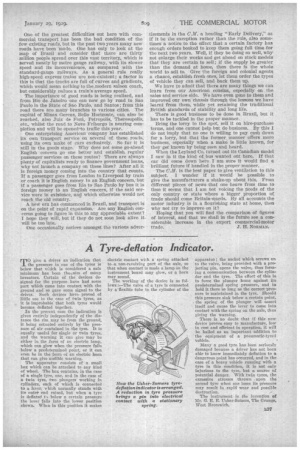A Tyre-deflation Indicator.
Page 21

If you've noticed an error in this article please click here to report it so we can fix it.
T°give a driver an indication that the pressure in one of the tyres is below that w.nch is considered a safe minimum has been the.,,aim of many inventors. Certain of the devices deigned for the purpose have had some part which came into contact with the ground and so gave some signal to the driver. Such devices have proved of little use in the case of twin tyres, as it is improbable that both tyres would
become deflated together.
In the preeent case the indication is given entirely independently of the distance the rim may he from the ground, it being actuated entirely by the pressure of air contained in the tyre. It is equally useful for single or twin tyres, and the warning it can give may be either in the .form of an electric lamp, which can glow when the pressure falls below a predetermined point, or it can even be in the form of an electric horn -that can give audible warning. The apparatus consists of a small box which can be attached to any kind of wheel. The box contains, in the ease of a single tyre, one, and in the ease of a twin tyre, two plungers working in cylinders, each of which is connected to a lever, v-lki,th normally stands with its outer end raised, but when a tyre is deflated I., below a certain pressure the lever falls into the lower position shown. When in this position it makes electric contact with a spring attached to a non-revolving part of the axle, so that when contact is made a lamp on the instrument board may glow, or a horn may sound.
The working of the device is as follows :--The valve of a tyre is connected by a flexible tube to the cylinder of the apparatus ; the socket which screws on to the valve, being provided with a projecting pin, opens the valve, thus forming a communication between the cylinder and the tyre. The effect of this is to force the plunger home against its predetermined spring pressure, and to bold it there so long as the correct piessore is maintained in the tyre. Should this pressure sink below a certain point, , the spring of the plunger will assert itself and cause the lever to come into contact with the spring on the axle, thus giving the warning.
There is no doubt that if this new device proves easy to manufacture, low in cost and efficient in operation, it will be hailed as an important addition to the equipment of a pneumatic-tyred vehicle.
Many a good tyre has been seriously damaged because a driver has not been able to know immediately deflation to a dangerous point has occurred, and in the ease of a heavy vehicle running with a tyre in this condition, it is not only injurious to the tyre, but a source of potential danger. With twin tyres, the excessive stresses thrown 'upon the second tyre when one loses its pressure may result in -rapid wear and possille destruction.
The instrument is the invention of Mr. G. E. B. Usher-Somers, The Grange, West Bromwich.


































